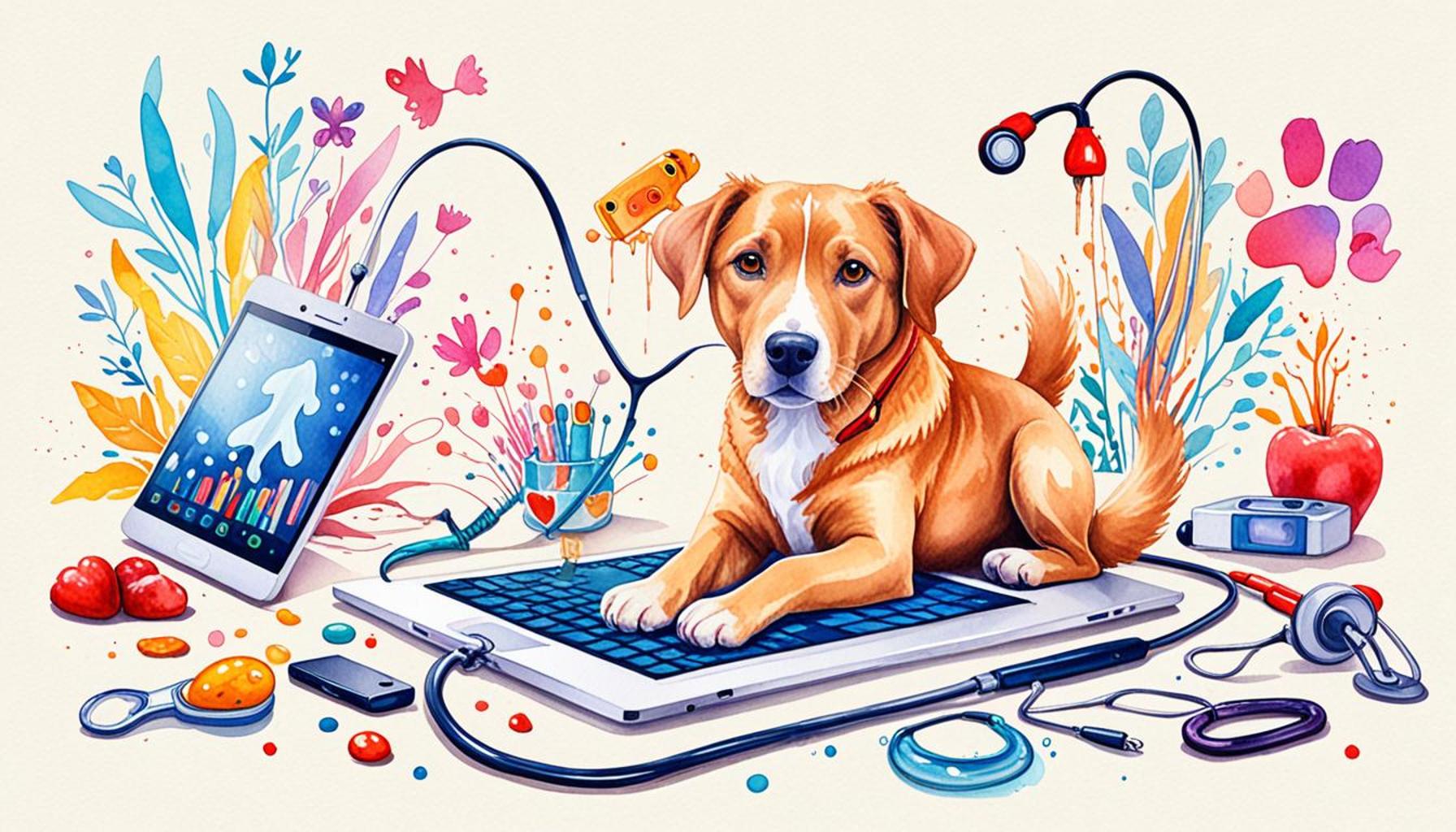How Technology is Transforming Pet Healthcare

The Revolutionary Changes in Pet Healthcare
The intersection of technology and pet care has ushered in a new era, revolutionizing the way pet owners approach their furry friends’ health. As the U.S. pet ownership rate continues to rise — with approximately 70% of households owning a pet, according to the American Pet Products Association — the demand for advanced solutions has also increased. Pet parents are more than ever looking for ways to ensure their pets lead healthy, fulfilling lives.
Advancements in veterinary medicine, digital platforms, and smart devices are not only enhancing the quality of care but also making it more accessible to pet owners from all walks of life. This revolution is built on several key elements:
- Telemedicine: Virtual vet consultations have gained popularity, offering convenience and reducing the stress traditionally associated with in-clinic visits. Platforms like Vetster and Pawp enable pet owners to consult licensed veterinarians online, quickly addressing minor ailments or getting professional advice. This option is particularly beneficial for those living in remote areas or with pets that experience anxiety during travel.
- Wearable Technology: Smart collars and health trackers have emerged as essential tools for monitoring pets’ activity levels and vital signs in real-time. Devices like the FitBark or the Whistle monitor not only activity but also specific health metrics, alerting owners of any irregular changes. These technologies offer insights that can lead to proactive healthcare management, thereby extending a pet’s lifespan.
- Mobile Apps: A myriad of applications have made it easier for pet owners to manage appointments, medications, and health records straight from their smartphones. Apps like PetDesk and Pawtrack facilitate scheduling veterinary visits and sending reminders for vaccination dates, ensuring that no critical health task is overlooked.
These innovations are fundamentally empowering pet owners, allowing for better-informed decisions regarding their pets’ health. The willingness of pet parents to invest in pet healthcare technology is notable, reflecting evolving attitudes towards the well-being of their companions. A study by MarketResearch.com indicates that the pet tech market is expected to reach $20 billion by 2025, underscoring the growing commitment to pet health.
As the roles of AI, data analytics, and telehealth continue to expand within the veterinary field, it becomes increasingly clear that technology signifies not just a trend, but a comprehensive shift in how we care for our pets. This transformation allows for a more individualized approach to pet healthcare, reminiscent of advancements in human medicine. Join us as we delve deeper into the extraordinary ways technology is altering the landscape of pet healthcare in the United States.
DISCOVER MORE: Click here for innovative training tips

Innovative Tools Enhancing Veterinary Practices
The integration of technology into veterinary practices is fundamentally changing how healthcare is delivered to our pets. Veterinarians are increasingly utilizing state-of-the-art tools that enhance diagnostics, treatment plans, and overall care, making the veterinary experience more efficient and effective. Innovations such as artificial intelligence (AI), robotic surgery, and advanced imaging techniques have emerged as game-changers in the veterinary field.
For starters, AI-powered diagnostic tools are revolutionizing the way veterinarians assess conditions. By leveraging machine learning algorithms, these tools analyze vast amounts of data from medical records and related studies to suggest potential diagnoses. Platforms like VetCT utilize advanced imaging technologies to provide tele-radiology services, allowing veterinarians to send and receive X-rays and CT scans from specialists in a timely manner. This not only speeds up the diagnostic process but also ensures that critical conditions are not missed.
Moreover, the advent of robotic surgical systems is introducing precision and finesse into surgical procedures. These systems allow for minimally invasive surgeries, which can lead to quicker recovery times and lower risks of complications for pets. Imagery-guided surgeries enabled by augmented reality are also becoming commonplace, allowing veterinary surgeons to enhance their precision during complex operations.
The following are some notable technological advancements shaping the future of pet healthcare:
- Telehealth Platforms: Besides telemedicine consultations, veterinarians are utilizing telehealth platforms to monitor and follow up with pets post-surgery. This continuous care fosters a healthier recovery process and builds a stronger bond between veterinarians and pet owners.
- 3D Printing: With the advent of 3D printing, custom prosthetics and anatomical models are now easily accessible to veterinary specialists. This technology can aid in creating tailor-made solutions for pets with specific joint issues or congenital defects, enhancing their quality of life.
- Data Analytics: Big data analytics is playing a pivotal role in understanding pet health trends. By analyzing aggregated data from various health records, veterinarians can make informed decisions about preventive care and help identify common health issues within specific breeds.
The transformation in pet healthcare is not merely about the tools themselves, but rather the improved outcomes these technologies promise. As veterinarians and pet caregivers better understand and utilize these innovations, a more proactive approach towards maintaining pet health is established. Vital health decisions informed by technology empower pet owners to support their pets’ well-being, reminding us that the future of pet care lies in a seamless blending of technology and compassion.
| Category | Advantages |
|---|---|
| Telemedicine | Access veterinary care remotely, reducing travel stress for pets. |
| Wearable Technology | Monitor health metrics like heart rate and activity levels in real-time. |
| AI-Powered Diagnostics | Enhanced accuracy in diagnosing illnesses, improving treatment outcomes. |
| Smart Pet Products | Automatic feeders and smart collars promote better feeding habits and safety. |
As technology continues to advance, pet healthcare is seeing a dramatic shift that not only benefits pets but also pet owners. With telemedicine, consultations can be conducted from the comfort of home, significantly reducing the stress associated with vet visits. Imagine being able to discuss your pet’s health with a qualified veterinarian through a mobile app, making healthcare accessible right at your fingertips.Moreover, wearable technology offers even more peace of mind. Pet owners can now monitor their furry companions’ vital signs and physical activity levels continuously. These devices can alert you to any unusual health patterns, allowing for immediate action if required.In addition, advancements in AI-powered diagnostics have made it easier for veterinarians to identify diseases early. These technologies analyze symptoms and historical data, providing insights that can lead to better treatment plans. It’s not just about monitoring health; smart pet products like automatic feeders and tracking collars can help establish better routines. These innovations not only improve the quality of life for pets but keep pet owners informed and engaged.
Dive deeper: Click here to discover innovative training techniques
Revolutionizing Pet Wellness Through Wearable Technology
In addition to advanced diagnostic tools and surgical innovations, wearable technology is emerging as a pivotal development in pet healthcare. Similar to fitness trackers used by humans, these devices are gaining traction among pet owners, allowing for real-time monitoring of their pets’ health metrics. From tracking activity levels to monitoring vital signs, these wearables are proving to be invaluable in proactive pet healthcare management.
One such example is the FitBark, a lightweight collar attachment that monitors a dog’s activity, sleep patterns, and overall health. By utilizing a smartphone app, pet owners can access detailed insights into their pet’s daily behaviors and health trends. This can be particularly important for detecting changes in activity or behavioral patterns that could signify potential health issues. Veterinary professionals increasingly encourage these devices, as they facilitate early detection of problems, thereby improving intervention outcomes.
Moreover, the advent of smart collars equipped with GPS tracking is adding another layer of safety for pets. These devices not only help locate lost pets but also track their geographic movements and habits. For instance, collars like the Whistle Go Explore allow owners to set virtual fences, sending alerts if their pet ventures beyond designated boundaries. This not only enhances the pet’s safety but also allows for better health management through tracking their outdoor activities, weight, and fitness.
Telemedicine: Bridging the Gap Between Pets and Vets
The rise of telemedicine has been accelerated by the growing demand for remote care solutions. Especially relevant in the wake of the global pandemic, telemedicine allows pet owners to consult with veterinarians without the need for in-person visits. This convenience is enshrined in various platforms like Pawp and Vetster, which enable virtual consultations and triage services.
These platforms expand access to veterinary care, especially for those in rural areas or those with mobility challenges. Pet owners can receive immediate advice on minor ailments, behavioral issues, or follow-ups after surgical procedures. Telemedicine opens up an interactive communication channel, making it easier for veterinarians to maintain continuous contact with patients and their owners, thus enhancing the overall quality of care.
Smart Software Solutions: Managing Pet Health Records
The digitalization of pet healthcare records is another transformative aspect of technology in this field. Software solutions like PetDesk and MyVetLINK are streamlining pet health management by allowing pet owners to access and manage their pet’s medical history, vaccination records, and appointment schedules all in one place.
These systems not only improve the organization of health records but also facilitate communication between pet owners and veterinary staff. By allowing for easier management of appointment reminders and preventive care alerts, these platforms emphasize the importance of regular check-ups and vaccinations. Furthermore, they serve to educate pet owners through tailored content and reminders relevant to their pets’ specific needs.
With these advances in technology, pet healthcare is becoming more holistic, connected, and efficient. The combination of wearables, telemedicine, and innovative software solutions are not just enhancing the way pets receive care, but also promoting a preventive approach that can lead to longer, healthier lives. As the technological landscape continues to evolve, it’s becoming evident that these tools are integral to fostering a healthier bond between pets and their caregivers.
DISCOVER MORE: Click here to learn about a healthy pet diet
Conclusion: A New Era of Pet Healthcare
As we’ve explored throughout this article, technology is profoundly transforming pet healthcare, offering innovative solutions that prioritize the well-being of our furry companions. The integration of wearable devices, such as activity trackers and smart collars, enables pet owners to monitor their pets’ health in real-time, leading to earlier detection of potential issues and fostering proactive care. Moreover, the rise of telemedicine has made veterinary services more accessible than ever, allowing for remote consultations that can address health concerns promptly, especially for those in underserved areas.
Additionally, the digitization of pet health records through platforms like PetDesk and MyVetLINK simplifies the management of medical histories, ensuring that pet owners stay informed and engaged with their pets’ health needs. This shift towards an organized, data-driven approach enhances communication between pet owners and veterinary professionals, ultimately resulting in better care outcomes.
Importantly, these technological advancements not only enhance the quality of healthcare but also enrich the bond between pets and their caregivers. As pet owners become more informed and involved in their pets’ health journeys, the potential for improved outcomes increases significantly. This evolution in pet healthcare underscores the critical role that technology will continue to play in shaping the future of animal welfare.
As we look ahead, it becomes crucial for pet owners to embrace these innovations and remain aware of emerging tools and trends. Whether it’s utilizing engaging apps, wearable technology, or telehealth services, the opportunities to provide the best possible care for our pets are expanding. In this digital age, the promise of improved pet health and well-being is nearer than ever before.


